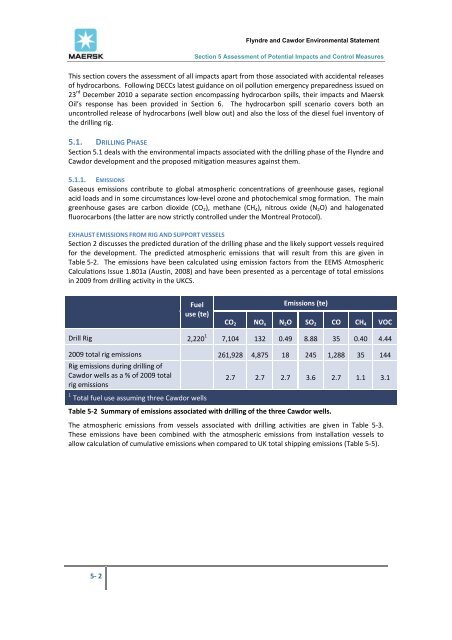Environmental statement - Flyndre and Cawdor - Maersk Oil
Environmental statement - Flyndre and Cawdor - Maersk Oil
Environmental statement - Flyndre and Cawdor - Maersk Oil
You also want an ePaper? Increase the reach of your titles
YUMPU automatically turns print PDFs into web optimized ePapers that Google loves.
5‐ 2<br />
<strong>Flyndre</strong> <strong>and</strong> <strong>Cawdor</strong> <strong>Environmental</strong> Statement<br />
Section 5 Assessment of Potential Impacts <strong>and</strong> Control Measures<br />
This section covers the assessment of all impacts apart from those associated with accidental releases<br />
of hydrocarbons. Following DECCs latest guidance on oil pollution emergency preparedness issued on<br />
23 rd December 2010 a separate section encompassing hydrocarbon spills, their impacts <strong>and</strong> <strong>Maersk</strong><br />
<strong>Oil</strong>’s response has been provided in Section 6. The hydrocarbon spill scenario covers both an<br />
uncontrolled release of hydrocarbons (well blow out) <strong>and</strong> also the loss of the diesel fuel inventory of<br />
the drilling rig.<br />
5.1. DRILLING PHASE<br />
Section 5.1 deals with the environmental impacts associated with the drilling phase of the <strong>Flyndre</strong> <strong>and</strong><br />
<strong>Cawdor</strong> development <strong>and</strong> the proposed mitigation measures against them.<br />
5.1.1. EMISSIONS<br />
Gaseous emissions contribute to global atmospheric concentrations of greenhouse gases, regional<br />
acid loads <strong>and</strong> in some circumstances low‐level ozone <strong>and</strong> photochemical smog formation. The main<br />
greenhouse gases are carbon dioxide (CO2), methane (CH4), nitrous oxide (N2O) <strong>and</strong> halogenated<br />
fluorocarbons (the latter are now strictly controlled under the Montreal Protocol).<br />
EXHAUST EMISSIONS FROM RIG AND SUPPORT VESSELS<br />
Section 2 discusses the predicted duration of the drilling phase <strong>and</strong> the likely support vessels required<br />
for the development. The predicted atmospheric emissions that will result from this are given in<br />
Table 5‐2. The emissions have been calculated using emission factors from the EEMS Atmospheric<br />
Calculations Issue 1.801a (Austin, 2008) <strong>and</strong> have been presented as a percentage of total emissions<br />
in 2009 from drilling activity in the UKCS.<br />
Fuel<br />
use (te)<br />
Emissions (te)<br />
CO2 NOx N2O SO2 CO CH4 VOC<br />
Drill Rig 2,220 1 7,104 132 0.49 8.88 35 0.40 4.44<br />
2009 total rig emissions 261,928 4,875 18 245 1,288 35 144<br />
Rig emissions during drilling of<br />
<strong>Cawdor</strong> wells as a % of 2009 total<br />
rig emissions<br />
1 Total fuel use assuming three <strong>Cawdor</strong> wells<br />
2.7 2.7 2.7 3.6 2.7 1.1 3.1<br />
Table 5‐2 Summary of emissions associated with drilling of the three <strong>Cawdor</strong> wells.<br />
The atmospheric emissions from vessels associated with drilling activities are given in Table 5‐3.<br />
These emissions have been combined with the atmospheric emissions from installation vessels to<br />
allow calculation of cumulative emissions when compared to UK total shipping emissions (Table 5‐5).








